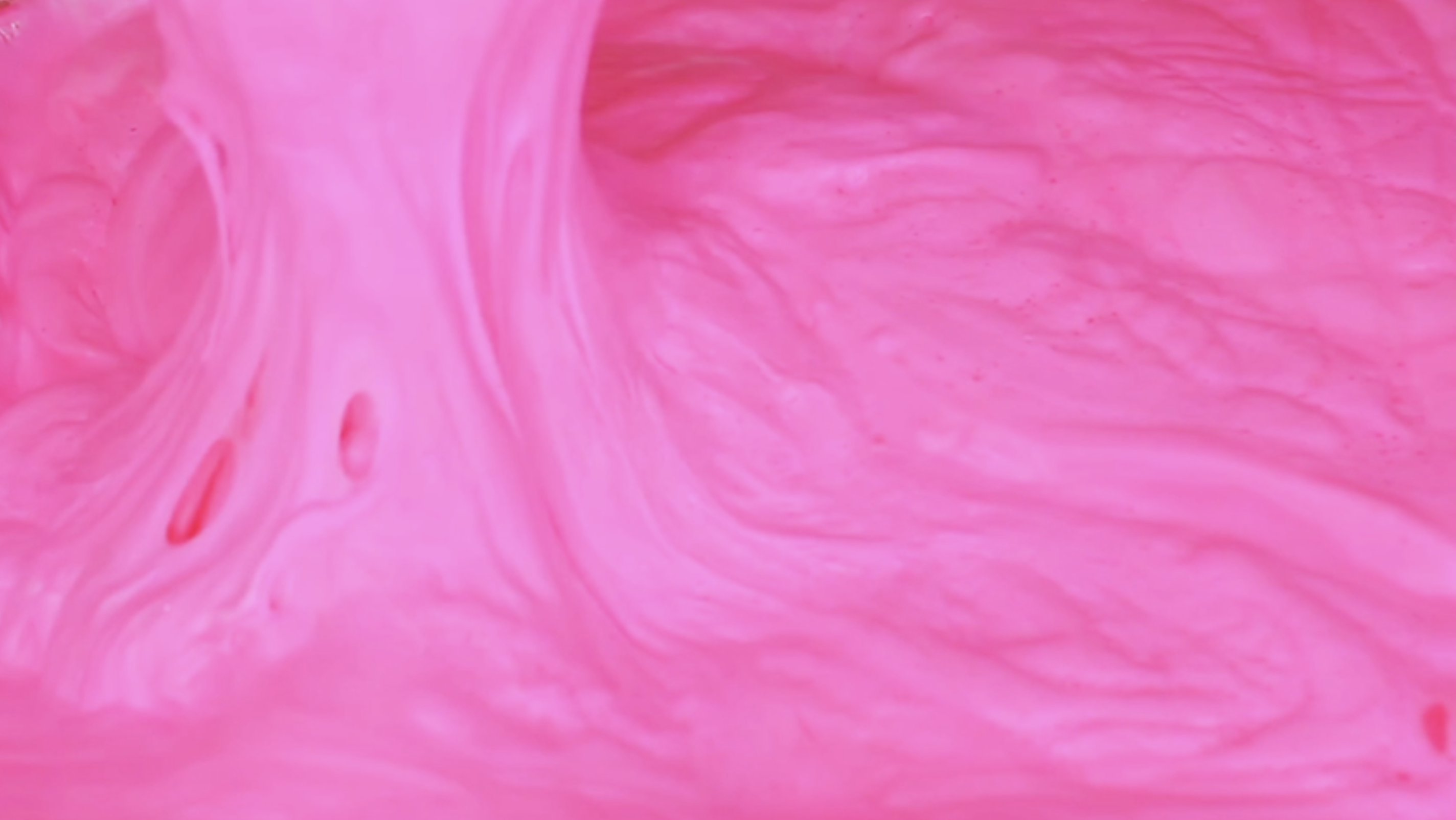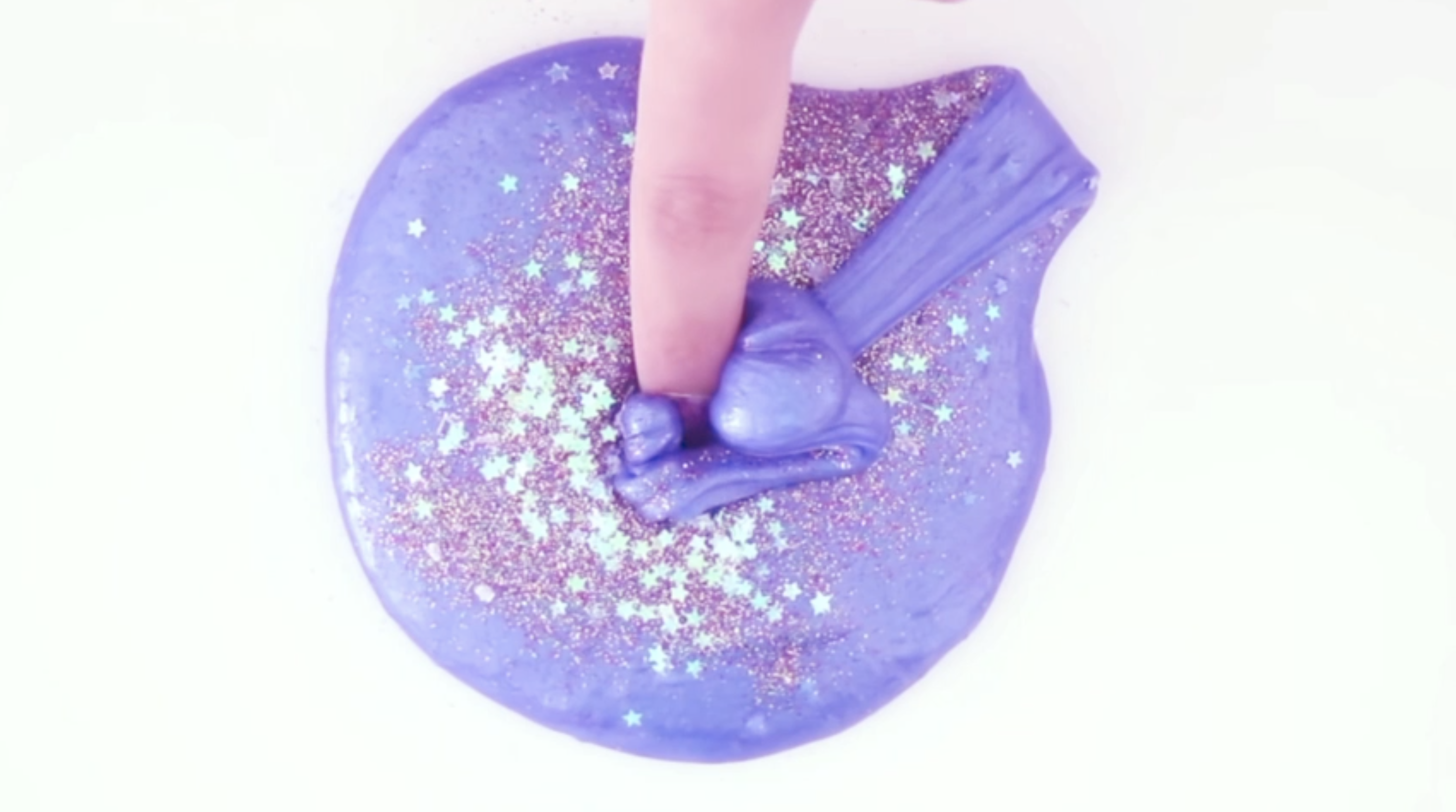
Still from video essay by Fiona Glen, source footage by Yo Yo
Slimy, Sticky, Sweet
Multimedia essay on cute slime, originally commissioned by Aww-Struck: Creative and Critical Approaches to Cuteness, a day-long seminar co-organised by Caroline Harris (Royal Holloway University) and Isabel Galleymore (University of Bristol). Slimy, Sticky, Sweet combines a wandering, mantra-like essay-script with a video essay that brings together found footage of slime making in looped, glitchy, ultra-saturated slow motion. It was presented online in May 2021 as part of Aww-Struck’s panel on Gender and Society. An Aww-Struck publication including another of my texts – an experimental poem called ‘As Syrup’ – was released by Poem Atlas and the University of Birmingham to accompany the seminar.
After having been presented and discussed at Aww-Struck, Slimy, Sticky, Sweet was published in July 2021 by SPAM Plaza as their first video essay, accompanied by an expanded essay. The piece delves into the sanitised and hyperfeminised new paradigm of slime, proliferating through platforms such as TikTok, Instagram and YouTube. In the essay-script, I consider cuteslime through the abject, the excessive, the idealised, the marketised, and the ecologically monstrous. Read, watch and listen to the full piece here.
Excerpt:
[...]
A glimmering trail follows embodiment. Slime in sex and birth and death, hatching and rotting. It is defensive and exposing. Mucus protects – and yet mucus membranes are soft sites of intense transmission. We all ooze. The slimes our own bodies release enter another in-between: the uneasy state between self and not-self.
I want cuteslime to be some kind of reclamation of the feminised abject and the stickiness of being in any body. I want this to be some statement of proud, pink fleshliness — a high-camp assertion that all humans do live with slime, close to ourselves and material things, forever changing, slippery and free. But maybe that’s just what I want to see.
Cuteslime is a fantasy: sanitised, strawberry-scented and shameless. It bubbles up from entrepreneurs, algorithms and influencers, a craze that just won’t calm, signalled by canned giggles and swelling web shops.
Cuteslime is deeply capitalist and deeply clean. It is has left bodies far behind. No chunks, no lumps. This is not secretion. Cuteslime does not seep thin in parts or leave wet marks. It is not organic.
It is synthetic evenness, even when it is pulled out into bubbled ribbons that rip a honeycomb of curves. Pure consistent colour or clarity. It does not have the jellied dangles of raw egg white, or the mottled bands of biofilm in our saliva.
Cuteslime is hyper-aesthetic. Visually delicious. Perfectly suited to the channels which amplify, refine and intensify it. A fragment among a million other images, it is, in itself, fascinating. It needs no context; it is its total meaning.
Endlessly various, cuteslime visibility entices more looking, making, buying, playing. Companies with names like Slimeowy and Kawaii Slime sell it under complex taxonomies: galaxy, glossy, bubble, float, crunchy, clay, unicorn, smoothie, velvet.
Having been a child under contemporary capitalism, I remember what it’s like to uncritically want all the slight, bright mutations of a product — the whole collectible catalogue. Cuteslime oozes forth — creatively, hungrily — from wealth. An encounter between the weird and the market.
Perhaps synthetic slimes can only be cute because we already live among them. Freddie Mason calls ‘gooeyness’ a distinctly ‘modern phase of matter’ in his book, The Viscous. [4] Since the mass extraction of petroleum began, slippery derivatives have proliferated. Slime that is not animal or vegetal but emerges from minerals and industry has become ever-more fashioned to our needs. Lube, LCD screens, lip gloss. Since Sartre wrote on it in 1943, slime has become a far dearer friend. It brings us pleasure, speed and beauty.
Maybe the digital feels less like a cloud and more like slime. Flows gather, bits stick, polluted pools at the sites of extraction grow a rich layer of scum. Slime is a mode of life, a medium of healthy lifeforms. But it is also a signal of ecological stress and distress: the sea snot clogging the Mediterranean, the blue algae choking out lakes, the green drench on a canal flooded with fertilisers. Industrial production is filled with sludges poured into moulds, molten slurries at the bottom of tanks, by-products and leftovers. Slime is the texture of inflow and outflow, of the invisibilised waste from the industrial production of our clean bright devices. Slime moves into and out of our things.
Like capitalism’s, cuteslime’s dirt is displaced from the site of its enjoyment. It is often made of plastics: glue, glitter, polystyrene, and microbeads. In the rare case that somebody wants to recycle synthetic slime, it can be dissolved in lemon juice and vinegar to produce a thin, grey, acid soup that can then be taken to a liquid waste treatment facility. But most of the time, cuteslime is simply binned.
Cuteslime is waste, masquerading as an escape from dirt. A plaything that you believe will never excrete.
Cuteslime could be your friend. It is calming, held in your hand like a pet. It has nearly learned to sit still. It is nearly obedient.
[...]
Stills:



